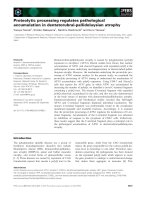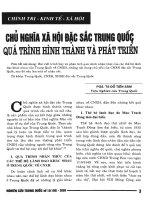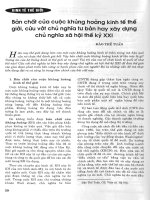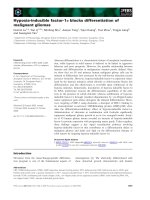Tài liệu Báo cáo khoa học: "Translating a Unification Grammar with Disjunctions into Logical Constraints" pdf
Bạn đang xem bản rút gọn của tài liệu. Xem và tải ngay bản đầy đủ của tài liệu tại đây (446.4 KB, 5 trang )
Translating a Unification Grammar with Disjunctions into Logical Constraints
Mikio Nakano and Akira Shimazu*
NTT Basic Research Laboratories
3-1 Morinosato-Wakamiya, Atsugi 243-0198 Japan
E-mail: ,
Abstract
This paper proposes a method for generating a logical-
constraint-based internal representation from a unifica-
tion grammar formalism with disjunctive information.
Unification grammar formalisms based on path equa-
tions and lists of pairs of labels and values are better
than those based on first-order terms in that the former
is easier to describe and to understand. Parsing with
term-based internal representations is more efficient than
parsing with graph-based representations. Therefore, it
is effective to translate unification grammar formalism
based on path equations and lists of pairs of labels and
values into a term-based internal representation. Pre-
vious translation methods cannot deal with disjunctive
feature descriptions, which reduce redundancies in the
grammar and make parsing efficient. Since the pro-
posed method translates a formalism without expanding
disjunctions, parsing with the resulting representation is
efficient.
1 Introduction
The objective of our research is to build a natural language
understanding system that is based on unification. The
reason we have chosen a unification-based approach is
that it enables us to describe grammar declaratively,
making the development and amendment of grammar
easy.
Analysis systems that are based on unification gram-
mars can be classified into two groups from the viewpoint
of the ways feature structures are represented: (a) those
using labeled, directed graphs (Shieber, 1984) and (b)
those using first-order terms (Pereira and Warren, 1980;
Matsumoto et al., 1983; Tokunaga et al., 1991).
In addition to internal representation, grammar for-
malisms can be classified into two groups, (i) those that
describe feature structures with path equations and lists
of pairs of labels and values (Mukai and Yasukawa,
1985; Ai't-Kaci, 1986; Tsuda, 1994), and (ii) those that
describe feature structures with first-order terms (Pereira
and Warren, 1980; Matsumoto et al., 1983; Tokunaga et
* Presently with Japan Advanced Institute of Science and Technology.
al., 1991). Since formalisms (i) are used in the family
of the PATR parsing systems (Shieber, 1984), hereafter
they will be called PATR-Iike formalisms.
Most of the previous systems are either ones that
generate representation (a) from formalisms (i) or ones
that generate representation (b) from formalisms (ii).
However, representation (b) is superior, and formalism
(i) is far better. Representation (b) is superior for
the following two reasons. First, unification of terms
is more efficient of that of graphs because the data
structure of terms is simpler (Sch6ter, 1993). l Second,
it is easy to represent and process
named disjunctions
(DSrre and Eisele, 1990) in the term-based representation.
Named disjunctions are effective when two or more
disjunctive feature values depend on each other. The
treatment of named disjunctions in graph unification
requires a complex process, while it is simple in our
logical-constraint-based representations. Formalism (i)
is better because term-based formalism is problematic
in that readers need to memorize the correspondence
between arguments and features and it is not easy to
add new features or delete features (Gazdar and Mellish,
1989).
Therefore, it is effective to translate formalism (i)
into representation (b). Previous translation methods 2
(Covington, 1989; Hirsh, 1988; SchSter, 1993; Erbach,
1995) are problematic in that they cannot deal with dis-
junctive feature descriptions, which reduce redundancies
in grammar. Moreover, incorporating disjunctive infor-
mation into internal representation makes parsing more
efficient (Kasper, 1987; Eisele and DSrre, 1988; Maxwell
and Kaplan, 1991; Hasida, 1986).
This paper presents a method for translating grammar
formalism with disjunctive information based on path
equations and lists of pairs of labels and values into term-
I Since unspecified features are represented by variables in term
unification, when most of the features are unspecified, it is inefficient
to represent feature structures by terms. In current linguistic theories
such as HPSG (Pollard and Sag, 1994), however, thanks to the type
specifications, the number of features that a feature structure can have
is reduced, so it does not cause as much trouble.
2Methods that generate representation (b) after generating represen-
tation (a) are included.
934
based representations, without expanding disjunctions.
The formalism used here
is feature-based formalism with
disjunctively defined macros
(FF-DDM), an extension of
the PATR-Iike formalisms that incorporates a descrip-
tion of disjunctive information. The representation used
here is
logical-constraint-based grammar representation
(LCGR), in which disjunctive feature structures are rep-
resented by Horn clauses.
2 Unification Grammar Formalisms with
Disjunctive Information
The main difference between PATR and FF-DDM is
that there can be only one definition for one macro
in PATR while multiple definitions are possible in FF-
DDM. These definitions are disjuncts. If the conditions
in one of the definitions of a macro are satisfied, the
condition the macro represents is satisfied. In FF-DDM,
the grammar is described using four kinds of elements:
type definitions, phrase structure rules, lexical entries,
and macro definitions.
Some examples are shown below. The first is an
example of type definition.
(1)
(deftype sign
pos agr subj)
This means that there is a type named
sign
and the
feature structures of type
sign
can have POS, AGR, and
SUBJ features.
This is an example of a phrase structure rule.
(2) (defrule psrl (s -> np vp)
(<s pos> = sentence
<np pos> = noun
<vp pos> = verb
<vp subj> = <rip>
<np agr> = <vp agr>
<s agr> = <vp agr>))
Here
psrl
is the name of this rule. Variable
s
denotes
the feature structure of the mother node, and np and
v-p are variables that denote the feature structures of the
daughter nodes. Rule psrl denotes the relationship
between three feature structures s, np, and v-p. The
fourth argument is a set of path equations. The path
equation <s pos> = sentence indicates that the
POS feature value in the feature structure represented
by the variable s is
sentence. The
path equation <vp
subj> = <np> means the suaJ feature value ofvp is
identical to the feature structure np. A path can be a list
of pairs of labels and values, although we do not explain
this in detail in this paper.
Next we show an example of a lexical item.
(3) (defword walk (sign)
(<sign pos> = verb
<sign agr> = <sign subj agr>)
(not3s <sign agr>))
Here
sign
is the variable that represents the lexical
feature structure for
walk.
The disjunctively defined
macro (not3s <sign agr>) in the last line shows
that the AGR feature value of sign must satisfy one of
the definitions of not3 s.
Examples of macro definitions, or definitions of
no t 3 s, are shown below.
(4) (defddmacro not3s (agr)
(<agr num>= sing)
(ist-or-2nd <agr per>))
(5) (defddmacro not3s (agr)
(<agr num>= plural))
If one of these is satisfied, the condition for macro
not3 s is satisfied. Two definitions, (4) and (5) stand in
a disjunction relation. 3
3 Logical-Constraint-Based Grammar
Representation
3.1 Logical Constraint Representation of
Disjunctive Feature Structures
We will first define logical constraints. A logical con-
straint
(constraint
for short) is a set of positive literals of
first-order logic. Each positive literal that is an element
of a constraint is called a
constraint element.
An example of a constraint is (6). Constraint elements
are written in the DEC-10 Prolog notation. The names
of variables start with capital letters.
(6) {p(X),
q(X,
f(r))}
A definition clause
of a predicate is a Horn clause having
that predicate as the predicate of its head. For example,
(7) is a definition clause ofp. 4
(7)
p(f(X, Y))
, {r(X), s(Y)}
The bodies of definition clauses can be considered as
constraints, that is, bodies can be considered to constrain
the variables in the head. For example, definition clause
(7) means that, for a pair of the variables X and Y,
p(f(X, Y))
is true if the instances satisfy the constraint
{r(X), s(Y)}. We omit the body when it is empty. The
set of definition clauses registered in the system is called
a database.
Feature structures that do not include any disjunctions
can be represented by first-order terms. For example, (8)
is described by (9).
POS v
]
(8) sign AGRsuBJ signagr [ PER 3rd
sing ]
[ agr
3rd J
3Since there is no limitation on the number of arguments of a macro,
named disjunctions can be described.
4Horn clauses are described in a different notation from DEC-10
Prolog so as to indicate explicitly that the bodies can be recognized as
constraints.
935
(9)
sign(v, agr( sing, 3rd), sign(_, agr( sing,
3rd), _))
Feature structure (8) is a
O'ped feature structure
used
in typed unification grammars (Emele and Zajac, 1990).
The set of features that a feature structure can have
is specified according to types. In this paper, we do
not consider type hierarchies. Symbol "_" in (9) is an
anonymous variable. The arguments of function symbol
sign
correspond to POS feature, AGR feature, and SUBJ
feature values.
Disjunctions are represented by the bodies of definition
clauses. A constraint element in a body whose predicate
has multiple definition clauses represents a disjunction.
For example, in our framework a disjunctive feature
descri ~tlon (10) 5 is represented by (11).
POS v
list "[
sign AGR *1 agr PER [2ndJ
(10) l agr [NUM
plural]
suB, sign [ AO, *1 ]
POS n ]
sign
AGR agr[ NUMPER
3rdSing]
(11) pCsign(v,
Agr,
sign(_, Agr,_)))
~ {not_3s(Agr)}
p( sign(n, ag ( ing, 3 d), _))
not_3s( agr( sing,
Per)) * {
l st_or.2nd( Per ) }
not_3s(ag (pt al,
_))
l st_or_2nd( l st ) ~
l st_or_2nd( 2nd) ,
Literal
p(X)
means that variable X is a candidate for the
disjunctive feature structure
(DFS) specified by predicate
p. The constraint element
lst_or_2nd(Per)
in (11)
constrains variable
Per
to be either
1st
or
2nd.
In
a similar way,
not_3s(Agr)
means that
Agr
is a term
having the form
agr(Num, Per),
and that either
Num
is
sing
and
Per
is subject to 1
st_or_2nd(Per)
or that
Num
is
plural.
As this example shows, constraint elements in
bodies represent disjunctions and each definition clause
of their predicates represents a disjunct.
3.2 Unification by Logical Constraint
Transformation
Unification of DFSs corresponds to logical constraint
satisfaction. For example, the unification of DFSs
p(X)
and
q(Y)
is equivalent to obtaining all instances of X
that satisfy {p(X), q(X)}.
In order to be able to use the result of one unification
in another unification, it would be useful to output results
in the form of constraints. Such a method of satisfaction
is called
constraint transformation
(Hasida, 1986). Con-
straint transformation returns a constraint equivalent to
the input when it is satisfiable, but it fails otherwise.
5 Braces represent disjunctions.
The efficiency of another unification using the result-
ing constraint depends on which form of constraint the
transformation process has returned. Obtaining compact
constraints corresponds to avoiding unnecessary expan-
sions of disjunctions in graph unification (Kasper, 1987;
Eisele and DSrre, 1988). Some constraint transformation
methods whose resulting constraints are compact have
been proposed (Hasida, 1986; Nakano, 1991). By using
these algorithms, we can efficiently analyze using LCGR.
3.3 Grammar Representation
LCGR consists of a set
of phrase structure rules,
a set of
lexical items,
and a
database.
Each phrase structure role is a triplate ( V , ~,
C /, where V is a variable, ~ is a list of variables,
and C is a constraint on V and variables in ~. This
means if instances of the variables satisfy constraint C,
they form the syntactic structure permitted by this rule.
For example,
( X ~ Y Z, {psrl(X,Y,Z)} )
means
if there is a set of instances x, y, and z of X, Y,
and Z that satisfies
{psrl(X, Y,
Z)}, the sequence of a
phrase having feature structure y and that having feature
structure z can be recognized as a phrase having feature
structure x.
Each lexical item is a pair
(w,p),
where w is a word
and p is a predicate. This means an instance of X
that satisfies {p(X)} can be a lexical feature structure
for word w. For example,
(walk, lex_walk I
means
instances of X that satisfy
{lex_walk(X)} are
lexical
feature structures for
walk.
The database is a set of definite clauses. Predicates
used in the constraints and predicates that appear in the
bodies of the definite clauses in the database should have
their definition clauses in the database.
4 Translation Algorithm
LCGR representation is generated from the grammar
in the FF-DDM formalism as follows. (i) Predicates
that represent feature values are generated from type
definitions. (ii) Phrase structure rules, lexical items, and
macro definitions are translated into LCGR elements.
(iii) Redundancies are removed from definite clauses
by reduction. Below we explain the algorithm through
examples.
Creating predicates that represent feature values
Let us consider the following type definition.
(12) (deftype sign
pos agr subj)
Then a feature structure of the type
sign
is represented
by three-argument term
sign(_,
_, _), and its arguments
represent Pos, AGR, and SUBJ features. By using this, the
following three definite clauses are created and added to
the database.
936
(13)
pos(sign(X,_,_),X)
agr(sign(_,X,_),X)
subj(sign(_,_,X),X)
Translation
of phrase structure rules, lexical items,
and macro definitions
Each of the phrase structure
rules, lexical items, and macro definitions is translated
into a definite clause and added to the database. This is
done as follows.
(I) Create a literal to be the head. In the case of
a phrase structure rule and a lexical item, let a
newly created symbol be the predicate and all the
variables in the third element be the arguments.
With macro definition, let the macro name be the
predicate and all the variables in the third element
be the arguments.
(II) Compute the body by using path equations and
disjunctively defined macros, and add the created
Horn clause to the database.
By using the predicates created at the step (I),
phrase structure rules and lexical items in LCGR
are created.
For example, let us consider the following lexical item
for verb
walk.
(14)
(defword walk (sign)
(<sign pos> = verb
<sign agr> = <sign subj agr>)
(not3s <sign agr>))
First at the step (I), a new predicate cO and LCGR
variable
Sign
that corresponds to sign are created,
cO(Sign)
being the head. At the step (II), <sign
pos> in the second line is replaced by the variable
X1 and
pos(Sign, X1 )
is added to the body. The
symbol verb is replaced by the LCGR constant
verb.
Then
eq(X l, verb)
is added to the body, where
eq
is a
predicate that represents the identity relation and that has
the following definition clause.
eq(X, X) ~
As for the third line, the path <sign agr> at
the left-hand side is replaced by X2, <sign subj
agr> at the right-hand side is replaced by X4,
and
{agr(Sign,
X2),
subj(Sign,
X3),
agr(X3,
X4)}
is added to the body. Then
eq(X2, X4)
is added
to the body. For macro (not3s <sign agr>),
<sign agr> is replaced by X5, and
agr(Sign, X5)
and
not3s(X5) are
added to the body. Then (15) is
added to the database.
(15) c0(Sign)
* { pos( Sign,
X 1),
eq( X 1, verb),
agr(Sign,
X2),
subj(Sign,
X3),
agr(X3,
X4),
eq(X2, X4),
agr(Sign,
X5),
not3s(X5)}
Finally,
(walk, cO)
is registered as a lexical item. Phrase
structure rules and macro definitions are translated in the
(III)
same way. Horn clause (16) is generated from (2), and (
S ~ NP VP, {el(S, NP, VP)} )
is registered.
(16) el(S,
NP, VP) ( { pos(S,
X1),
eq(Xl, sentence),
pos(NP,
X2),
eq(X2, noun), pos(VP,
X3),
eq(X3, verb), subj(VP,
X4),
eq(X4, NP),
agr(NP,
X5),
agr(VP,
X6),
eq(X5,
X6),
agr(S,
X7),
agr(VP,
X8),
eq(X7,
X8)}
In the same way, Horn clauses (17) are generated from
the macro definitions (4) and (5).
(17)
not3s( A gr ) * {num( Agr, X
1),
eq( X l, sing),
per( Agr,
X2),
l st_or_2nd( X 2 ) }
not3s( Agr ) ~{num( Agr, X
1),
eq( X 1, plural)}
In the above translation process, ifa macro m has multiple
definitions, predicate m' also has multiple definitions.
This means disjunctions are not expanded during this
process.
Removing Redundancy by Reduction In the defini-
tion clauses created by the above proposed method, many
predicates that have only one definition clause are used,
such as predicate
eq,
predicates representing feature val-
ues, and predicates representing macro that have only one
definition. We call these predicates
definite predicates.
If these definition clauses are used in analysis as they
are, it will be inefficient because the definition clause of
definite predicates must be investigated every time these
clauses are used.
Therefore, by using the procedure
reduce
(Tsuda,
1994) each literal whose predicate is definite in the body
is replaced by the body of its definition clause.
Let us consider (18) below as an example. If the sole
definition clause of c2 is (19), c2(X, Y) in (18) is unified
with the head of (19). Then, (18) is transformed into
(20).
(18)
cl(f(X), Y)
, {eZ(X, Y)}
(19)
c2(g(A, B), Y)
*-{c3(A), c4(B)}
(20)
cl(f(g(A, B)), Y)
~ {c3(A), c4(B)}
By using this operation, Horn clause (15) above is trans-
formed into the following one.
cO(sign(verb, X 6, sign(X7, X 6,
X8)))
~ {not3s( X 6) }
Since
not3s
has two definitions,
not3s(X6)
is not re-
placed. Consequently, the disjunction denoted by
not3s
is not expanded in this translation.
5 Experiment
The advantage of this method compared to the previous
methods is that it can translate without expanding dis-
junctions. To show this, we compared the time taken
for two analyses: the first using a grammar translated
937
into terms after expanding disjunctions 6 and the second
using a grammar translated without expanding disjunc-
tions through our method. The computation times were
measured using a bottom-up chart parser (Kay, 1980)
in Allegro Common Lisp 4.3 running on Digital Unix
3.2 on DEC Alpha station 500/333MHz. It employs
constraint projection (Nakano, 1991) as an efficient con-
straint transformation method. We measured the time
for computing all parses. We used a Japanese grammar
based on Japanese Phrase Structure Grammar (JPSG)
(Gunji, 1987) that covers fundamental grammatical con-
structions of Japanese sentences. For all of 21 example
sentences (5 to 16 words), the time taken for analysis
using the grammar translated without disjunction expan-
sion was shorter (43% to 72%). This demonstrates the
advantage of our method.
6
Conclusion
This paper presented a method for translating a grammar
formalism with disjunctive information that is based on
path equations and lists of pairs of labels and values
into logical-constraint-based grammar representations,
without expanding disjunctions. Although we did not
treat type hierarchies in this paper, we can incorporate
them by using the method proposed by Erbach (1995).
Acknowledgments
We would like to thank Dr. Ken'ichiro Ishii, Dr. Takeshi
Kawabata, and the members of the Dialogue Understand-
ing Research Group for their comments. Thanks also go
to Ms. Mizuho Inoue and Mr. Yutaka Imai who helped
us to build the experimental system.
References
Hassan Ai't-Kaci. 1986. LOGIN: A logic programming
language with built-in inheritance. Journal of Logic
Programming, 3:185-215.
Michael Covington. 1989. GULP 2.0: An extension
of Prolog for unification-based grammar. Technical
Report AI- 1989-01, The University of Georgia.
Jochen D6rre and Andreas Eisele. 1990. Feature logic
with disjunctive unification. In COLING-90, vol-
ume 2, pages 100-105.
A. Eisele and J. D6rre. 1988. Unification of disjunctive
feature descriptions. In ACL-88, pages 286-294.
Martin C. Emele and R6mi Zajac. 1990. Typed unifi-
cation grammars. In COLING-90, volume 3, pages
293-298.
Gregor Erbach. 1995. ProFIT: Prolog with features,
inheritance and templates. In EACL-95, pages 180-
187.
6Note that disjunctions whose elements are all atomic values are
not expanded.
Gerald Gazdar and Chris Mellish. 1989. Natural Lan-
guage Processing in Lisp: An Introduction to Compu-
tational Linguistics. Addison-Wesley.
Takao Gunji. 1987. Japanese Phrase Structure Gram-
mar. Reidel, Dordrecht.
K6iti Hasida. 1986. Conditioned unification for natural
language processing. In COLING-86, pages 85-87.
Susan Hirsh. 1988. P-PATR: A compiler for unification-
based grammars. In V. Dahl and E Saint-Dizier, ed-
itors, Natural Language and Logic Programming, II,
pages 63-78. Elsevier Science Publishers.
Robert T. Kasper. 1987. A unification method for dis-
junctive feature descriptions. In ACL-87, pages 235-
242.
Martin Kay. 1980. Algorithm schemata and data struc-
tures in syntactic processing. Technical Report CSL-
80-12, Xerox PARC.
Yuji Matsumoto, Hozumi Tanaka, Hideki Hirakawa,
Hideo Miyoshi, and Hideki Yasukawa. 1983. BUP: A
bottom-up parser embedded in Prolog. New Genera-
tion Computing, 1:145-158.
John T. Maxwell and Ronald M. Kaplan. 1991. A method
for disjunctive constraint satisfaction. In Masaru
Tomita, editor, Current Issues in Parsing technology,
pages 173-190. Kluwer.
Kuniaki Mukai and Hideki Yasukawa. 1985. Com-
plex indeterminates in Prolog and its application
to discourse models. New Generation Computing,
3(4): 145-158.
Mikio Nakano. 1991. Constraint projection: An efficient
treatment of disjunctive feature descriptions. In ACL-
91, pages 307-314.
Fernando C. N. Pereira and David H. D. Warren. 1980.
Definite clause grammars for language analysis a
survey of the formalism and a comparison with aug-
mented transition networks. Artificial Intelligence,
13:231-278.
Carl J. Pollard and Ivan A. Sag. 1994. Head-Driven
Phrase Structure Grammar. CSLI, Stanford.
Andreas Sch6ter. 1993. Compiling feature structures
into terms: an empirical study in Prolog. Technical
Report EUCCS/RP-55, Centre for Cognitive Science,
University of Edinburgh.
Stuart M. Shieber. 1984. The design of a computer
language for linguistic information. In COLING-84,
pages 362-366.
Takenobu Tokunaga, Makoto Iwayama, and Hozumi
Tanaka. 1991. Handling gaps in logic grammars.
Trans. of Information Processing Society of Japan,
32(11):1355-1365. (in Japanese).
Hiroshi Tsuda. 1994. cu-Prolog for constraint-based
natural language processing. IEICE Transactions on
Information and Systems, E77-D(2): 171-180.
938









